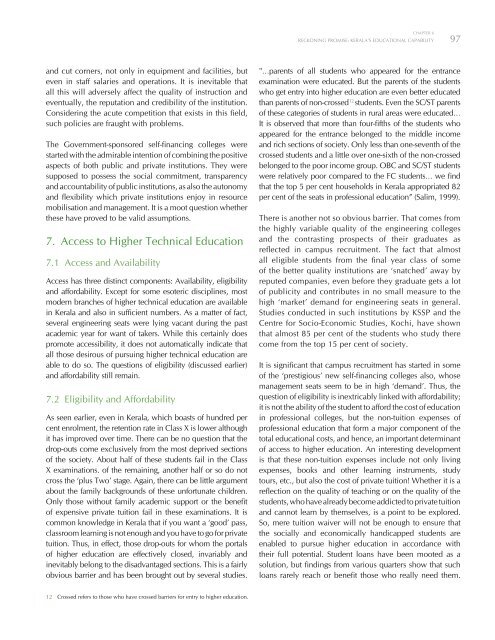Kerala 2005 - of Planning Commission
Kerala 2005 - of Planning Commission
Kerala 2005 - of Planning Commission
You also want an ePaper? Increase the reach of your titles
YUMPU automatically turns print PDFs into web optimized ePapers that Google loves.
CHAPTER 6<br />
RECKONING PROMISE: KERALA’S EDUCATIONAL CAPABILITY<br />
97<br />
and cut corners, not only in equipment and facilities, but<br />
even in staff salaries and operations. It is inevitable that<br />
all this will adversely affect the quality <strong>of</strong> instruction and<br />
eventually, the reputation and credibility <strong>of</strong> the institution.<br />
Considering the acute competition that exists in this field,<br />
such policies are fraught with problems.<br />
The Government-sponsored self-financing colleges were<br />
started with the admirable intention <strong>of</strong> combining the positive<br />
aspects <strong>of</strong> both public and private institutions. They were<br />
supposed to possess the social commitment, transparency<br />
and accountability <strong>of</strong> public institutions, as also the autonomy<br />
and flexibility which private institutions enjoy in resource<br />
mobilisation and management. It is a moot question whether<br />
these have proved to be valid assumptions.<br />
7. Access to Higher Technical Education<br />
7.1 Access and Availability<br />
Access has three distinct components: Availability, eligibility<br />
and affordability. Except for some esoteric disciplines, most<br />
modern branches <strong>of</strong> higher technical education are available<br />
in <strong>Kerala</strong> and also in sufficient numbers. As a matter <strong>of</strong> fact,<br />
several engineering seats were lying vacant during the past<br />
academic year for want <strong>of</strong> takers. While this certainly does<br />
promote accessibility, it does not automatically indicate that<br />
all those desirous <strong>of</strong> pursuing higher technical education are<br />
able to do so. The questions <strong>of</strong> eligibility (discussed earlier)<br />
and affordability still remain.<br />
7.2 Eligibility and Affordability<br />
As seen earlier, even in <strong>Kerala</strong>, which boasts <strong>of</strong> hundred per<br />
cent enrolment, the retention rate in Class X is lower although<br />
it has improved over time. There can be no question that the<br />
drop-outs come exclusively from the most deprived sections<br />
<strong>of</strong> the society. About half <strong>of</strong> these students fail in the Class<br />
X examinations. <strong>of</strong> the remaining, another half or so do not<br />
cross the ‘plus Two’ stage. Again, there can be little argument<br />
about the family backgrounds <strong>of</strong> these unfortunate children.<br />
Only those without family academic support or the benefit<br />
<strong>of</strong> expensive private tuition fail in these examinations. It is<br />
common knowledge in <strong>Kerala</strong> that if you want a ‘good’ pass,<br />
classroom learning is not enough and you have to go for private<br />
tuition. Thus, in effect, those drop-outs for whom the portals<br />
<strong>of</strong> higher education are effectively closed, invariably and<br />
inevitably belong to the disadvantaged sections. This is a fairly<br />
obvious barrier and has been brought out by several studies.<br />
"…parents <strong>of</strong> all students who appeared for the entrance<br />
examination were educated. But the parents <strong>of</strong> the students<br />
who get entry into higher education are even better educated<br />
than parents <strong>of</strong> non-crossed 12 students. Even the SC/ST parents<br />
<strong>of</strong> these categories <strong>of</strong> students in rural areas were educated…<br />
It is observed that more than four-fifths <strong>of</strong> the students who<br />
appeared for the entrance belonged to the middle income<br />
and rich sections <strong>of</strong> society. Only less than one-seventh <strong>of</strong> the<br />
crossed students and a little over one-sixth <strong>of</strong> the non-crossed<br />
belonged to the poor income group. OBC and SC/ST students<br />
were relatively poor compared to the FC students… we find<br />
that the top 5 per cent households in <strong>Kerala</strong> appropriated 82<br />
per cent <strong>of</strong> the seats in pr<strong>of</strong>essional education” (Salim, 1999).<br />
There is another not so obvious barrier. That comes from<br />
the highly variable quality <strong>of</strong> the engineering colleges<br />
and the contrasting prospects <strong>of</strong> their graduates as<br />
reflected in campus recruitment. The fact that almost<br />
all eligible students from the final year class <strong>of</strong> some<br />
<strong>of</strong> the better quality institutions are ‘snatched’ away by<br />
reputed companies, even before they graduate gets a lot<br />
<strong>of</strong> publicity and contributes in no small measure to the<br />
high ‘market’ demand for engineering seats in general.<br />
Studies conducted in such institutions by KSSP and the<br />
Centre for Socio-Economic Studies, Kochi, have shown<br />
that almost 85 per cent <strong>of</strong> the students who study there<br />
come from the top 15 per cent <strong>of</strong> society.<br />
It is significant that campus recruitment has started in some<br />
<strong>of</strong> the ‘prestigious’ new self-financing colleges also, whose<br />
management seats seem to be in high ‘demand’. Thus, the<br />
question <strong>of</strong> eligibility is inextricably linked with affordability;<br />
it is not the ability <strong>of</strong> the student to afford the cost <strong>of</strong> education<br />
in pr<strong>of</strong>essional colleges, but the non-tuition expenses <strong>of</strong><br />
pr<strong>of</strong>essional education that form a major component <strong>of</strong> the<br />
total educational costs, and hence, an important determinant<br />
<strong>of</strong> access to higher education. An interesting development<br />
is that these non-tuition expenses include not only living<br />
expenses, books and other learning instruments, study<br />
tours, etc., but also the cost <strong>of</strong> private tuition! Whether it is a<br />
reflection on the quality <strong>of</strong> teaching or on the quality <strong>of</strong> the<br />
students, who have already become addicted to private tuition<br />
and cannot learn by themselves, is a point to be explored.<br />
So, mere tuition waiver will not be enough to ensure that<br />
the socially and economically handicapped students are<br />
enabled to pursue higher education in accordance with<br />
their full potential. Student loans have been mooted as a<br />
solution, but findings from various quarters show that such<br />
loans rarely reach or benefit those who really need them.<br />
12 Crossed refers to those who have crossed barriers for entry to higher education.

















